Turkey is especially important to the pigeon fancier interested in the history and biology of domestication, because, as in the case of dogs, it is either an important way station out of Asia (as I and the Turkish fanciers think) or a point of origin. As I have written in my book Aloft-- see left-- all the most ancient breeds of pigeon, most used for flight competition or admired for beauty or voice, rather than "practical" breeds for food, come from an area around the Mediterranean stretching from Egypt through Arabia all the way through Turkey. As the West becomes more aware of Asian culture it seems that such birds are also found all the way up into the "Stans", and perhaps always have been. There are mentions of "Middle Eastern"- sounding breeds in 19th Century and early 20th Century British books on Central Asia, which I collect. The old way of thinking was that they were first kept in the Middle East, the "Cradle of Civilization", ,and brought east by Islam. But that's where Europeans looked. New evidence, much of it biological, keeps pushing most domestications east and north, following what has come to be known as the Silk Road (this is perhaps my most serious semi- scholarly preoccupation). Of course such early domestication would have to have been done by nomads or even hunters, who used to get no respect. When I found the Turkish pigeon website a few years ago, I was amazed that they took it for granted that their nomadic Asian ancestors brought their pigeons down from the northeast,and that they even associated some breeds with Shamanism! (See their entries on Trumpeters).
I will not go on too long with this "Pigeon Wonkery", but I should add a few more things before the photos. One is that I have never seen such a pigeon culture, both urban and rural. In Sanliurfa, when I had a chance, i would go out on my hotel balcony at dawn (easy when awakened by the call to prayer at 5:30!) and dusk to watch easily fifty competing flocks in the sky above. I also saw pigeons, high- quality ones, in the bazaar and even in a restaurant! (See below). The countryside was the same-- birds of a quality that could bring hundreds of dollars in the US evading Pergrines on the village outskirts.
To begin: Rock Doves-- real ones, not feral mutts-- over the Euphrates. Even if the domestic birds originate further east, this, as Darwin first demonstrated, was the original bird (yes, it's found through Asia too, but these are the first real wild ones I ever saw).
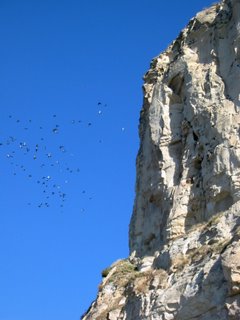
The importance of pigeons in Turkey might be symbolized by this artful signed photo of an "Urfa Guvercin" (Urfa pigeon, actually a diving dewlap-- see the website), complete with jewelry bands, in the lobby of Urfa's finest hotel.

Many of the breeds in Turkey are kept in cupboard lofts. This was in the lobby of a semi- outdoors restaurant, as you will be able to see in the next two photos.
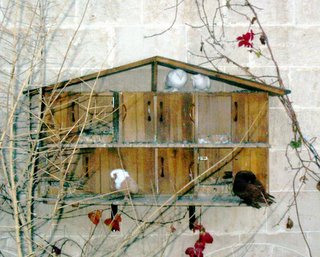
Two beautiful red trumpeters on the restaurant sign:
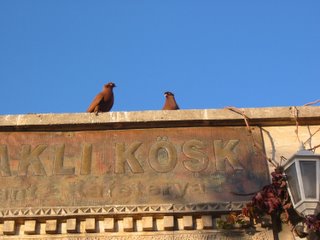
White trumpeters and a Shirazi or Shaksharli tumbler below the balcony where I am eating.

A young "Damascene" (our culture tends to use Arabic- rooted names for the eastern breeds, as they have come mostly from Lebanon or Syria to the States) in the bazaar. The color is called "ice"
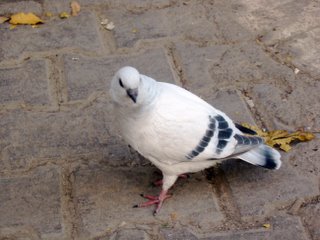
In the villages. These "Lebanons" are big enough to eat, though also beautifully colored.
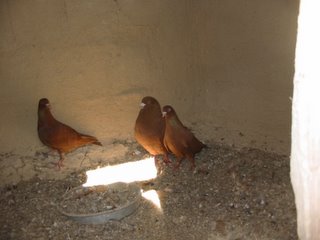
I apologize for the photo quality, but these Swifts were not going to let me close in with my little digital. The one in the foreground had just almost contemptuosly evaded a passing Peregrine, which to be fair didn't try too hard-- experience? Thet were flocked up with some nondescript but athletic tumblers. One kept leaping into the wind from his perch on a wire, hovering in place, and doing a backflip.
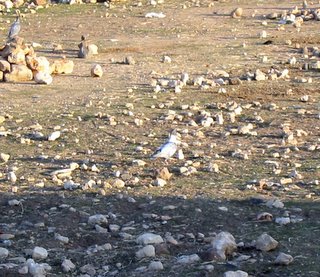
All these traditional pigeon cultures seem secure, but I wonder. They are under seige from Islamists, who see them as frivolous (see "Talibanning Pigeons", left) and from the modern fear of germs and dirt, the need to control (see the post on Chicago and pigeons, below, plus many posts on animal control, microchipping, etc.). Janet just sent me this item on Bird Flu in fowl near Urfa. Pigeons are less susceptible than fowl, hawks than pigeons-- but will anyone care? Already a neighbor-- tellingly, one of the rich "nouveau Magdalenians" rather than the natives-- has enquired suspiciously of me: "what are you going to do about your birds?" if Bird Flu comes (uuhhh-- lock them up until it passes?)
So: long may they fly. I wish you could actually see the flocks in this shot of Urfa at dusk, but the resolution is I fear too small. But they are still there-- so far.
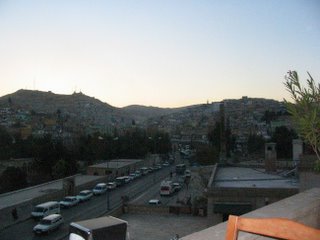
"And in the isolation of the sky
At evening, casual flocks of pigeons make
Ambiguous undulations as they sink
Downward to darkness, on extended wings."
-Wallace Stevens
Update: here is another fine Turkish pigeon site in English, with good photos, showing even more breeds.
4 comments:
whao. pigeon lover here...how old are u anyway? 50? 60? 70?
A flock of common pigeons used to feed in the baseball diamond behind my high school. This is neither here nor there (and maybe too revealing), but as a sophomore I used to spend my lunch hours trying to kill one with a matched set of boomerangs I made. You could get about as far as mid-field behind second base and then you had to throw. I never hit one but like the think I came close a few times. ...Could this be why I didn't get asked to the Sadie Hawkins dance?
Here's a poem from my notebook that year, doubtless inspired by lunchtime pigeon-hunting:
"A wheeling white pigeon
begs the eye the boon
of observation--
Crossing, a white wing
draws lift from the wind
and the dark center
of each observing eye."
For the pigeon lover above-- almost 56 if anyone cares.
that was really great post.. Bird control
Post a Comment